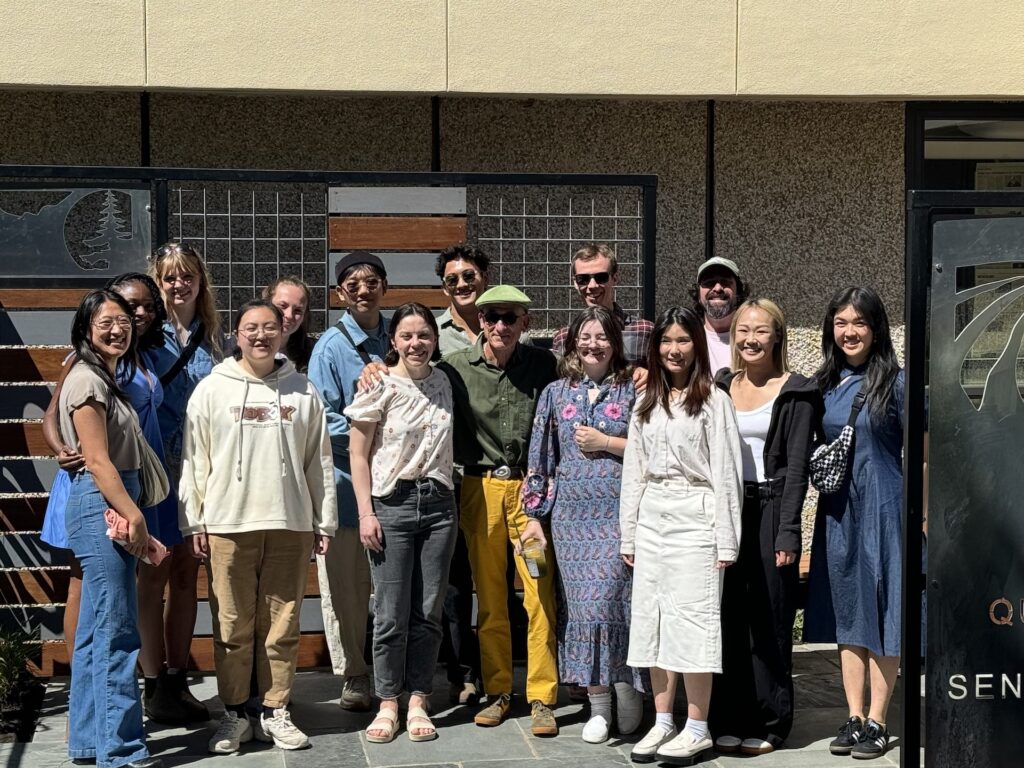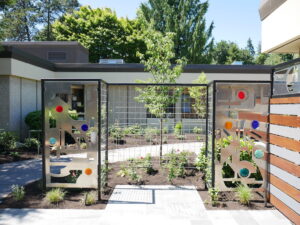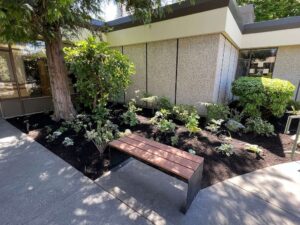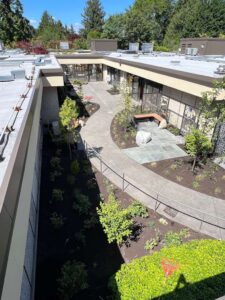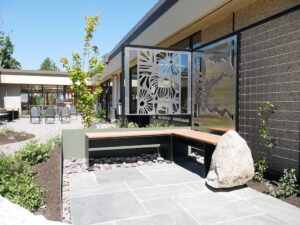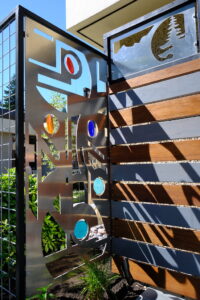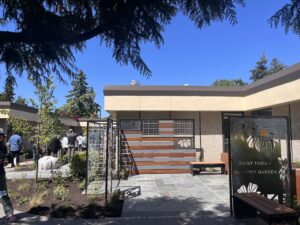On June 6th, 2024, Kline Galland community members and staff gathered with our 2024 UWLA Design Build students and families to dedicate the Quint Family Sensory Garden. This is the second of two courtyard gardens at the KlineGalland skilled nursing and rehabilitation home designed and built by Professor Daniel Winterbottom and his team.
Check out a timelapse of the construction of the sensory garden
You can read some of the speeches from our faculty and students below:
Daniel Winterbottom at the Quint Family Sensory Garden Design Build Dedication (6.6.2024):
Welcome and thank you all for joining us to celebrate the completion of the Quint Family Sensory Garden. A special place that has been created over the last 20 weeks and many of you have devoted your energy, time and brawn in both the design and implementation of this garden. It appears in its finished state so effortless, as if it belongs here, and yet it’s hard to believe that in January you, the students were asking your 20-year-old selves what’s it like to be 50 – 60 years older than I am today? You came and asked residents and staff what was important to them. You did research about aging and exercises such as negotiating the corridors of Gould Hall in a wheelchair, picking out bolts with oversized gloves and other simulation exercises to better understand the realities of aging.
Today we witness the results of you understanding, compassion and selflessness that is now manifested in this most recent addition to the Kline Galland Home, a design that is responsive and expresses your collective vision in its own unique way. Bravo! I do hope the process has been meaningful to all who participated.
You were given an opportunity and you have embraced it with many of you taking on high levels of responsibility for furniture design, graphic design of the panels, art lighting of the stones, learning the craft of masonry in a few weeks, and choosing appropriate and sensory stimulating plantings and more. More importantly I hope that you now have a better understanding of the value and power of nature to engage, comfort, stimulate and delight those who may be facing physical, psychological, social or mobility challenges. Inevitably as one becomes older, one’s physical and often social world also becomes proportionately reduced. As this occurs views from a window, access to beautiful spaces, opportunities to socialize with family, friends and fellow residents become even more important. This is not only particularly valuable for the residents, but also for the staff who while working long, intensive hours now have a green space in which they can benefit from the attention restoration that nature offers and reenergize themselves in a place that offers respite and fascination. As intended in the design we also hope that this space can also be used for community celebrations, outdoor workshops and performances.
To the students: Most of you will now be entering a new chapter in your life journey, no longer a formal student, though much of your learning is only beginning, but you will be exploring your chosen profession and the opportunities it offers. I hope this project is just a starting point in your journey, that you will take the lessons learning over past few years, and more specifically the last 20 weeks and seek out communities in critical need, those most marginalized, outcast, and powerless to bring beauty, improved health, hope and care to them, to use all your abundance of creativity, ingenuity, intellect and empathy to manifest the ideal, or at least spend the precious little time we have on this earth to try.
I’d like to just thank a few people for whom this project would not have been possible. The visionary for these gardens, including this most recent one is Min An who truly understands the value of nature particularly in a residential setting as this. I would not have met Min if not for Pat Lagerwell who I met while working at the Puget Sound VA and who introduced Min and I many years ago, thank you Pat.
Jeff Cohen, CEO has been a long-time advocate for the gardens and Nate Nusbaum has been instrumental in raising the funds for the gardens. These are but a few of the staff whose support we have received from Kline Galland, we could not have done this project without so many others from differing departments, facilities, volunteer services, finance and many, many others. To all of who you from Kline Galland that have patiently supported us and cleaned the spaces where we have created messes in thank you, thank you, thank you!
I would also like to thank Ken Yocom chair of my department of landscape architecture for his unwavering support of the design build program. Without Zach Meyer and Jeremy Watson, who codirected the construction and Amy Wagenfeld who co-taught the design this project would not have been possible.
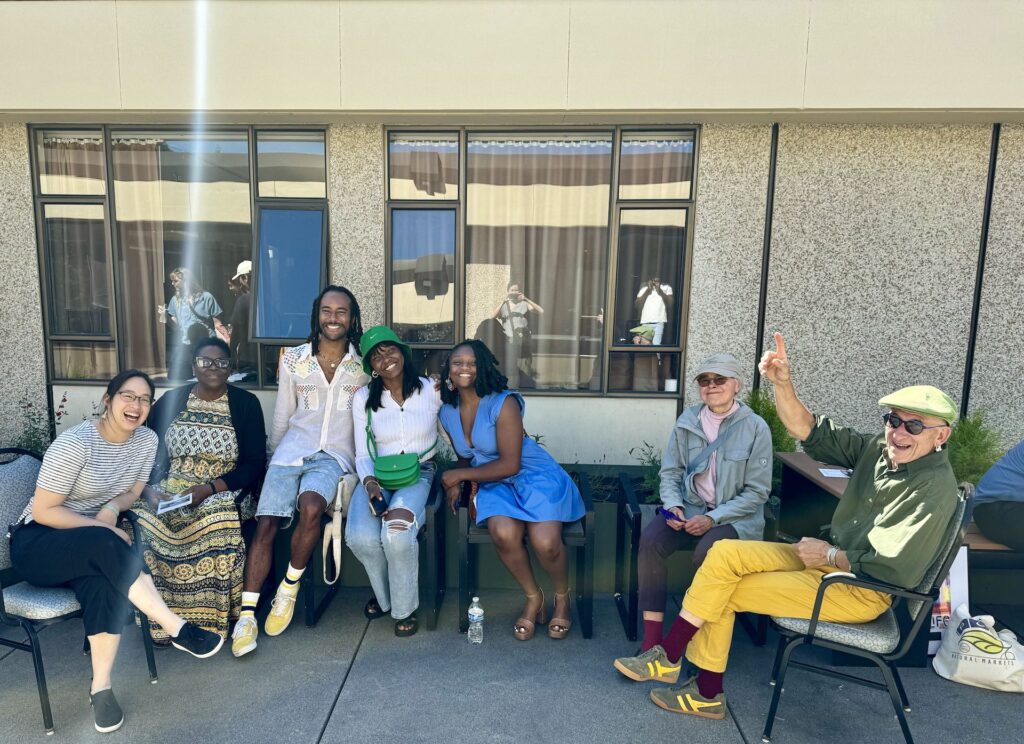
Of course it’s the students:
Helen Elizabeth Arnold
Griffin Cronk
Molly Lara Ferguson
Sharon Foeng
Vasilisa Karp
Hanbeom Lee
Edward Chak Yan Li
Jessica Liao
Shantol Morgan
Ying Shan
Bing Wan
Eve Yixuan Wang
And those who worked on the design:
Ellie Anderson
Joanna Chen
Nidhi Jain
Radhika Sarda
that have shown up every day, dedicating themselves to this project and to you I give my deepest, heartfelt thanks. I hope each, and everyone one of you leaves this garden with a heart swollen with pride as you have left something invaluable for the community whom you have served.
Finally, I’d like to extend by deepest thanks to the Quint family who has generously and selflessly given the resources to make this project possible. Toda raba. Thank you.
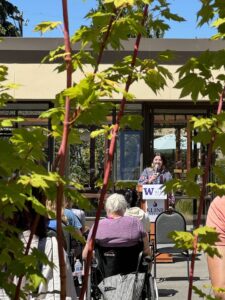
Vasilisa Karp, BLA 2024 to the Kline Galland Community (6.6.2024):
Hello everyone! I am so unbelievably thankful for you to be here to see the results of our last six months of work.
In winter, we came here, week after week, showing you all kinds of posters and models and ideas until we got to something resembling what you’re seeing here today. I think I speak for everyone when I say we’ve all learned a lot on this project, and it’s incredible to see the way this place has changed in as little as three months— looking at it now, it’s hard to remember what used to be here, with the old cracked concrete and rhododendron walls.
From your input, we worked hard to create a garden that was unlike any of the others here, and what came from that was this concept of a modern but deeply sensory garden. My hand in this design was all these little plants around you. I spent a long time pouring over different handbooks of local knowledge and garden designs with the intention of using many things that could be found in your home garden as well. For me, this was my first time seeing a design I carefully drafted actually implemented into the real world, and I had no idea how complicated but also how deeply satisfying it is to see the results of my labor manifest in real time. I think that’s the same for everyone. We all have our own little part of the garden that we saw through to the end, and I think that’s what makes this place so special. I can see a little piece of all my classmates’ efforts everywhere. Anyway, I spent so long on the plants that some of my classmates have started calling me geeky over these things—but we’re landscape architects, we should know our plants!
While they look small now, these were all chosen with a consideration for their historical uses and medicinal qualities. With time, this garden will bloom into a space rich with spiritual qualities from plants like Solomon’s Seal and Bleeding Heart, and if you move towards the planters you’ll catch the scent of our wonderful sages and lavenders.
Helen Arnold, BLA 2024 to the Kline Galland Community (6.6.2024):
Hi everyone—thanks for coming—my name is Helen and I’d like to talk a little bit about what this project has meant to me.
A big part of my revived passion and motivation, [in landscape architecture] has been our client. Daniel’s studios are so special because they bring theory and social change beyond the hypothetical. Designing for communities in need is one thing, but actually getting to do something about it is really empowering: It’s grounding to know that what we are designing will be built. During my time at UW, I’ve gotten to explore the ways in which ecological and human health intertwine. Getting to bring these different teachings and experiences together in this space is really special. We had the opportunity to start to get to know this population through focus groups last quarter. Speaking with the residents, their family members, and staff helped guide our process. I know that the therapeutic benefits of outdoor spaces can impact not only the residents and staff themselves, but reach beyond to friends and family members at home. I’m excited to finally be welcoming this community into this space, and hope that it will be a place of healing, revival, and joy.
I cannot forget the special community of my classmates that I’ve gotten to know over the past 6 months. Something about digging holes in a giant mud pit really brings people together! I remember on the first day, we were shoveling a whole lot of dirt, and Bing said to me, “do you think we’re gonna have to do this again?” (the answer was, yes)
I’m so happy that this garden brought us together and I hope that its impact will be deeply felt by the staff and residents of Kline Galland. It’s been such a special spring with you guys and I’m so grateful to have been a part of this project. Let’s celebrate the minutes and hours spent together learning new skills, practicing old ones, and making change together. To the mud, and the steel, and the spontaneous potlucks, and to all of us, and to Daniel, Watson and Zach, and most of all to Kline Galland—Cheers!
